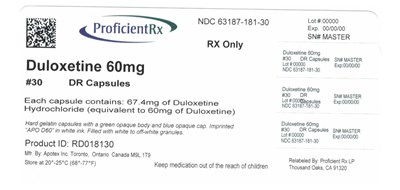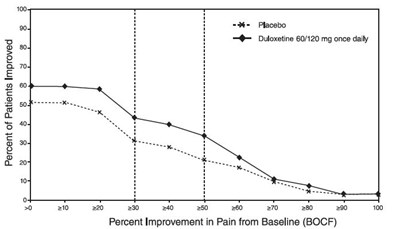Product Images Duloxetine Hydrochloride
View Photos of Packaging, Labels & Appearance
Product Label Images
The following 8 images provide visual information about the product associated with Duloxetine Hydrochloride NDC 63187-181 by Proficient Rx Lp, such as packaging, labeling, and the appearance of the drug itself. This resource could be helpful for medical professionals, pharmacists, and patients seeking to verify medication information and ensure they have the correct product.
Duloxetine 60mg - Duloxetine 60mg

This is a drug labeled as Duloxetine 60mg made by Apotex Inc. in Canada. It comes in a bottle of #30 DR capsules, with an NDC number of 63187-181-30, and is imprinted with "APO D60." The capsules are hard gelatin, with a green opaque body and blue opaque cap filled with white to off-white granules. It is recommended to store this medication between 20°-25°C (68°-77°F) and to keep it out of reach of children. The drug should not be used without a doctor's prescription. The bottle has a label indicating that it was relabeled by Proficient Rx LP in California.*
Duloxetine 30mg - dulo 30mg

This is a prescription drug called Duloxetine in the form of capsules. Each capsule contains 30mg of Duloxetine Hydrochloride. It comes in a package of #30 DR Capsules with an identification number NDC 63187-172-30. The capsules are white to off-white with "APO D30" imprinted in green ink. It is manufactured by Apotex Inc. in Toronto, Ontario, Canada, and marketed by Proficient Rx LP, Thousand Oaks, CA. The product should be stored at 20°-25°C (68°-77°F), and out of the reach of children. Lot number and expiration dates are provided in the packaging.*
Figure 1 - dulodpnp1

This appears to be a table showing the percentage of patients who experienced improvement while taking various dosages of Duloxetine compared to a placebo, measured by percentage improvement in pain from baseline. There are four treatment options listed: Duloxeline 60mg BID, Duloxetine 60mg QD, Duloxetine 20mg QD, and Placebo. The data suggests that the Duloxetine options resulted in higher percentages of improvement than the placebo, with the highest improvement percentage shown for the Duloxetine 60mg QD option. The last number in the table is 260, which likely represents the highest percentage of improvement achieved overall.*
Figure 2 - dulodpnp2

This seems to be a chart that shows the percentage of patients who showed improvement in their pain levels after taking either Duloxetine (in different doses) or a placebo. The x-axis shows the percentage improvement in pain from baseline while the y-axis shows the percentage of patients who improved. There are 3 lines on the chart - one for Duloxetine 60mg twice a day, another for Duloxetine 60mg once a day, and the third for placebo. However, the text is not properly formatted and contains errors, making it difficult to accurately interpret the data.*
CLBP-fig-5 - figure5

The text shows a graph with the percent improvement of patients in pain management after taking either a placebo or Duloxetine 60/120 mg once daily. The percent of patients improved is indicated to be 100%.*
CLBP-fig-6 - figure6

This is a graph that shows the percentage of patients who have improved with a placebo and duloxetine 60 mg once daily. The x-axis displays varying percentages ranging from 0 to 100, and the y-axis shows the number of patients who improved with the medication. There is also a line graph showing the percent improvement in pain from baseline using the BOCF method.*
CLBP-fig-7 - figure7

The text represents a chart displaying the percentage of patients who experienced improvement in pain after being treated with placebo versus duloxetine 60/120 mg daily. The vertical axis shows the percentage of improvement while the horizontal axis shows the numerical values of the percentages. The chart indicates that duloxetine demonstrated a higher percentage of patients experiencing improvement in pain compared to placebo. The numbers shown are difficult to interpret without further context or explanation.*
* The product label images have been analyzed using a combination of traditional computing and machine learning techniques. It should be noted that the descriptions provided may not be entirely accurate as they are experimental in nature. Use the information in this page at your own discretion and risk.
